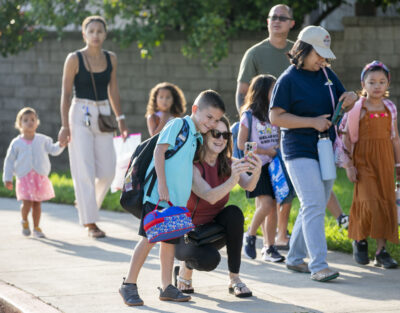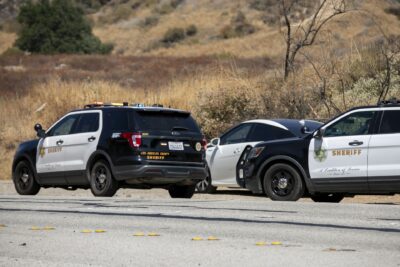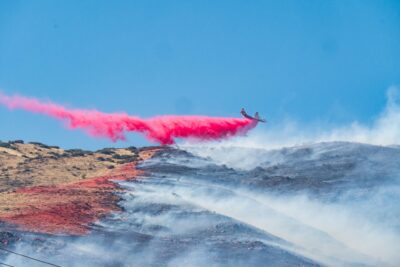The Castaic landfill producing more than 1 million gallons of leachate every week drew a strong rebuke from officials and residents Friday over claims by Waste Connections that L.A. County 5th District Supervisor Kathryn Barger called “deeply troubling.”
“There are no risks to public safety,” read the hand-distributed flyer that showed up on doorsteps in the Castaic and Val Verde community last week.
The flyer also accuses “politicians” of making Chiquita Canyon Landfill “the target of misinformation attacks and deployed rhetoric to mislead the community about the mitigation efforts.”
Data from the landfill’s paid consultants, according to the flyer, “show decreased surface emissions, which means there is less landfill gas that could be leaving the landfill,” which also reflects a “decrease in emissions and show improvement in offsite air quality.”
However, for more than two years now, air regulators — including the ones at a June 24 South Coast Air Quality Management District hearing board meeting that placed more restrictions on the landfill — have said that is not the case.
On Friday, Barger called out the landfill in a demand for accountability, which the county is seeking in a federal lawsuit due back in court July 17.
“Let me be clear: The gases and odors being released by the landfill are impacting the lives of residents,” she wrote in a statement shared via email by Helen Chavez, her communications director. “I have acknowledged this from the start, and I will continue to demand accountability and relief from the party that’s responsible — the landfill’s owners and management company.”
The landfill has been accused of using partial and misleading information, overloading residents with dense and overly technical reports where transparency is required and “gamesmanship” over accountability measures officials have tried to put in place.
Landfill officials have denied this and cited millions spent in relocation for several months last year before the landfill abruptly ended the fund at the end of February, two months after the landfill’s closure.
The company said the timing of the letter was related to “incomplete and inaccurate information” that’s being spread about the elevated landfill temperature event, which is the source of the landfill’s pollution.
“Chiquita has taken significant steps to contain and manage this complex reaction, including using customized technologies and implementing robust strategies recommended by our technical experts,” read a statement Monday afternoon from Chiquita Canyon, sent via email by John Musella, spokesman for the landfill. “We have worked hand-in-glove with local, state, and federal regulatory bodies throughout this ETLF event.”
It called claims from the community otherwise are “unfounded and baseless.”
The landfill said the reaction and smell have been getting better, despite direct claims from county and state officials that the opposite was true.
Air officials have said with evidence the landfill’s reaction size has doubled, with no end in sight.
Chiquita’s flyer also dismissed any potential cancer concerns, using language that Barger said was misleading.
Barger said that, while there’s been no proven link yet, that doesn’t mean one does not exist. Health officials are still working on challenges in analyzing the data from the cancer-cluster claims, such as inconsistencies in the local housing tract maps, according to officials.
“The state’s Department of Public Health has committed to releasing updated analyses when more complete data becomes available, and I will continue to push for that transparency,” Barger wrote in the email.
The Los Angeles Cancer Surveillance Program, which conducted the initial survey on behalf of the USC Keck School of Medicine, did not respond to a request for comment Monday.
At the L.A. County-Chiquita court hearing, Judge Maame Ewusi-Mensah Frimpong is expected to rule on a request for a mandatory preliminary injunction against Waste Connections and Chiquita Canyon, demanding that it resume the assistance program it ended four months ago.
The county estimates the cost of helping the 938 households that saw the highest number of complaints with $4,000 a month for six months would cost approximately $22.5 million.
Jennifer Elkins, president of the Val Verde Civic Association, said in a statement sent via text message Monday that the landfill has been misleading community members for years and they are tired of being “gaslighted.”
“The truth is, there is not enough being done to protect residents. We are experiencing both short-term and long-term health impacts,” she wrote. “It is a slap in the face for the landfill to put flyers on our doorsteps stating that, ‘There are no potential health impacts attributable to the emissions from the landfill.’”
The county said the funds that aren’t used for relocation can help the thousands of others in the community who have been impacted by the landfill.
“Any funds not used for relocation could be allocated to the 2,476 households that made complaints resulting in NOVs, to allow those households to harden their homes against the odor,” according to the motion filed by L.A. County Counsel. “Relocating residents for six months gives defendants time to abate their nuisance and control the odors.”
The landfill has garnered close to 30,000 complaints in the more than two years since its most recent problems began.








